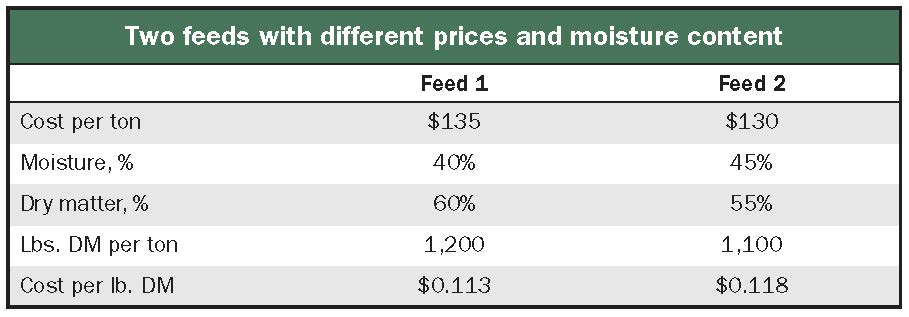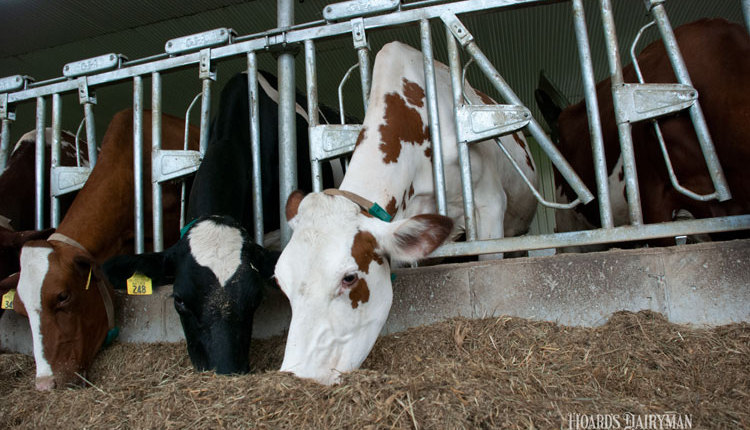
Commodity feeds are no different. With substantially rising feed costs, you are likely considering different options to lessen the feed cost per hundredweight (cwt.) line item on your expense report. For example, two different sources of distillers grains, corn gluten feed and almond hulls may seem comparable, but there are basic nutritional aspects that need to be accounted for when comparing options.
Take a long view
Prior to discussing different ways to improve margin, recognize that decisions we make today will have a lasting impact on your herd’s health and performance. As was discussed in Abby Bauer’s April 19 Hoard’s Dairyman Intel, “Feed prices climb but cows don’t change,” when considering ration adjustments during high feed costs, do not shortchange your high-performing dairy cows. The results can be disastrous. This includes hunting for deals with seemingly low-priced feeds.
In recent conversations with a few nutritionists in southern Wisconsin, we recognized the need to reset and cover the basics when comparing different feed options. It all starts with moisture. In our discussions, we found several dairies in the area had thought they’d secured good buys only to recognize moisture differences shifted the feed cost economics.
Don’t buy water
Moisture is the water present per pound, bushel, or ton. This may seem rudimentary, but the point here is that water in purchased feed brings no economic value and dilutes out valuable dry matter. When comparing commodity feed options, we have to first exclude the water and look at the price per pound of dry matter before accounting for other nutritional factors.
Consider the following example in the table illustrating different distillers grains options that we could buy. Feed 1 and Feed 2 are modified distillers grains plus soluble options that can be trucked in. Feed 2 looks to be the better buy at surface level. However, the price per ton difference between Feed 1 and Feed 2 is deceiving.

The 5-percentage unit moisture difference between the two modified distillers grains options washes away any economic benefit with Feed 2. Feed 1 actually presents the best option in price per pound of dry matter.
Consider your options
To break down your feed options on a dry matter basis and calculate the cost per pound of dry matter for different commodity options such as shown in the table, work through these steps:
1. Begin by calculating pounds of dry matter per ton. For example, with 12% moisture: 2,000 x (100 - 12)/100 = 1,760 pounds of dry matter per wet ton.
2. Divide price per ton by the pounds of dry matter per ton. For example, with $210 per ton: $210/1,760 = $0.119 per pound of dry matter.
You may opt to bring in your nutritionist for help here. The next step after working through these calculations yourself is to ensure you have a clear understanding of the actual moisture content for the feed when it hits your bin or commodity shed. Do not take the sales sheet for granted.
An example moisture and feed nutrition analysis provided by the broker is a good starting point to consider. However, moisture content in modified wet or dry feeds can change over time. Forward-thinking dairies are tracking moisture in purchased feeds just like they do in forages. This is because the economic-minded farms have recognized hidden value at times with feeds like canola meal, soybean meal, or even corn grain.
The hidden value is rooted in more dry feed being delivered per ton when moisture content dips well below tag guarantees or what is expected. Think of this like buying a bushel of corn in a bag, only to weigh it and recognize the plant weighed out 60 pounds instead of 56. In my opinion, moisture content should be monitored for any feed included in your ration at greater than roughly 3 pounds per cow.
The next level
Beyond moisture content, work with your nutritionist to also consider value per pound of protein or starch for protein or energy feeds. This begins to be a more complex calculation, but comparing apples to apples is a pertinent first step in making the right economic decisions. There are helpful online worksheets such as FeedVal version 7.0 or SESAME available from the University of Wisconsin or The Ohio State University animal and dairy science extension teams.
Above all, make sure you account for the different moisture content present in purchased feeds when making the decision for your herd. Do not find yourself paying for a limited trim level truck only to find out after the fact that you actually bought a contractor truck.









